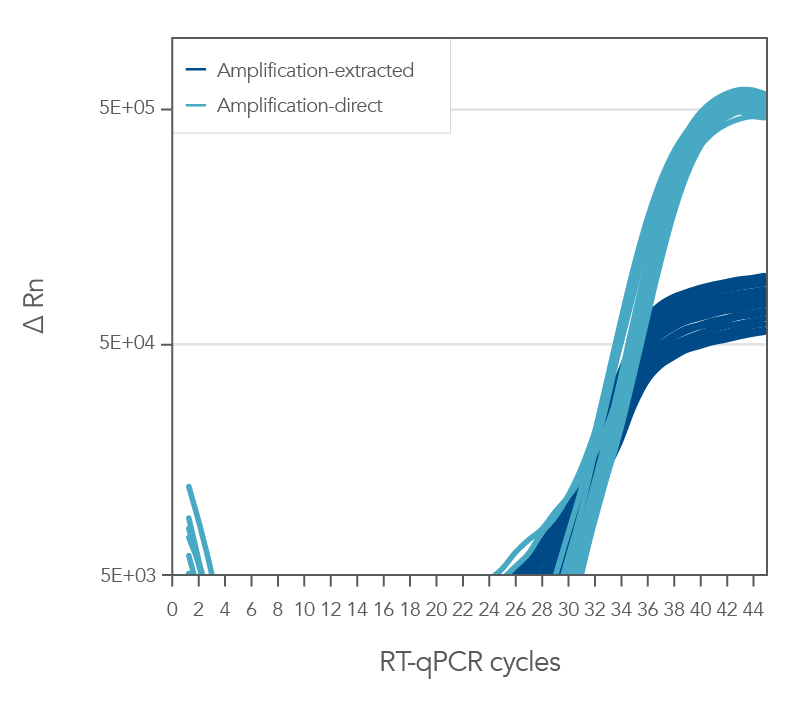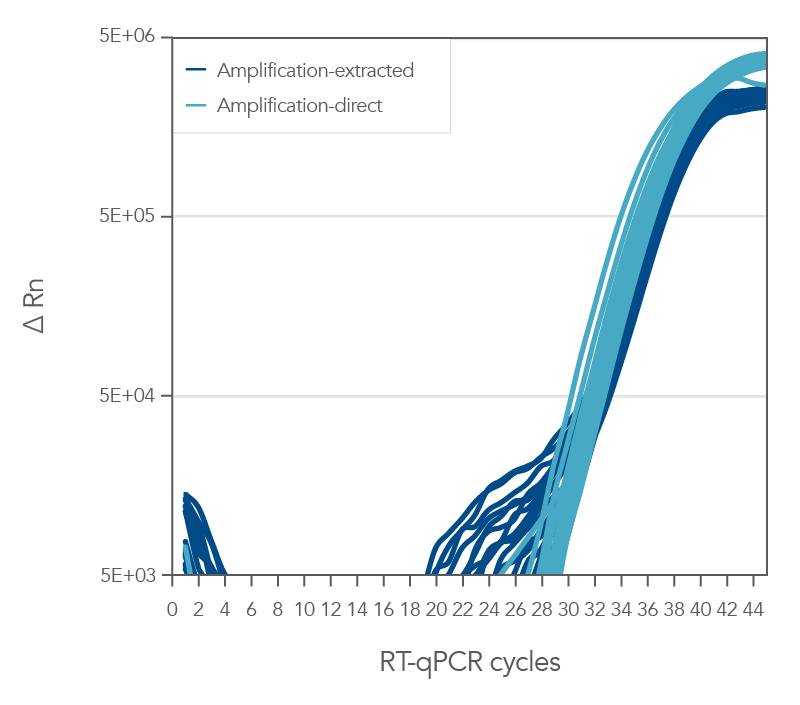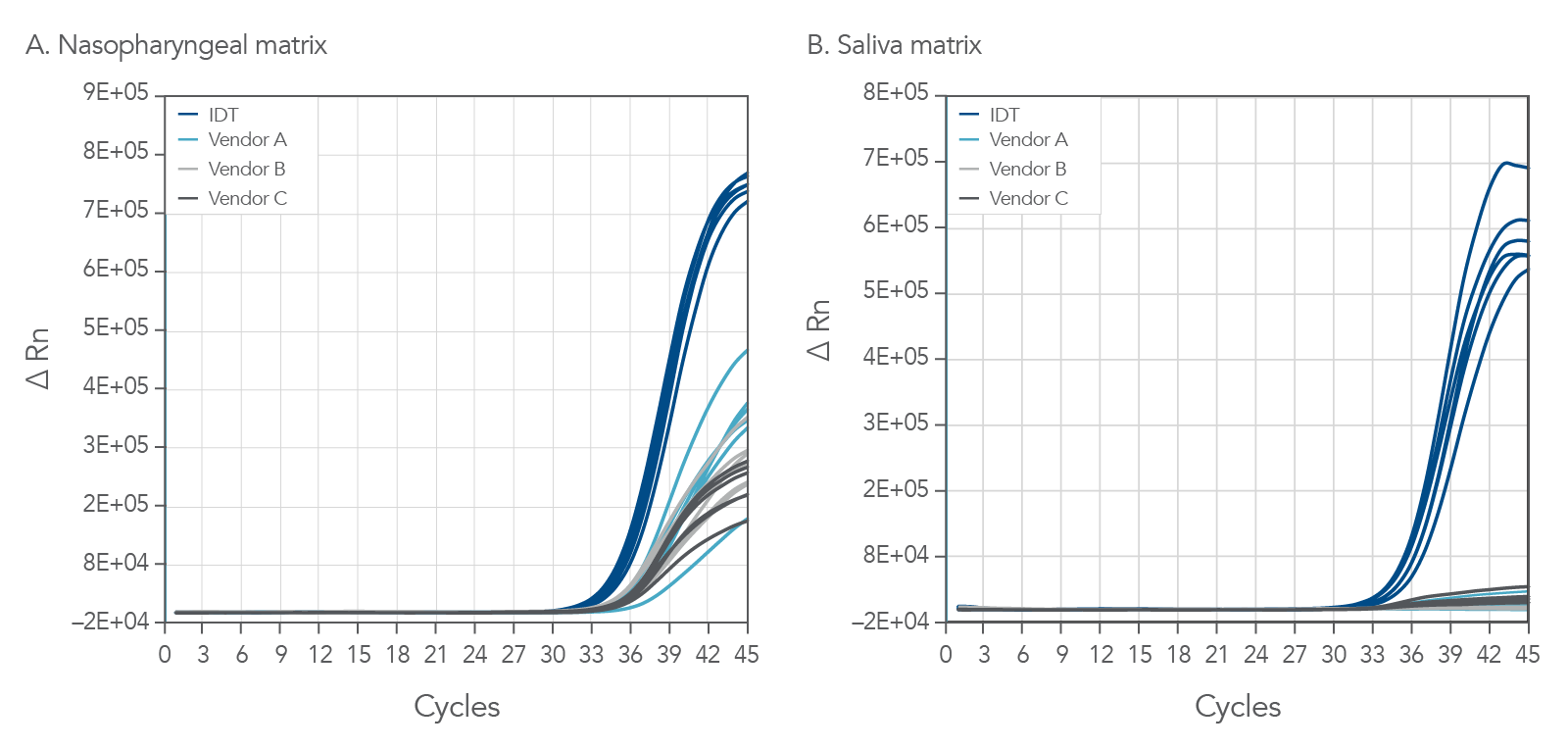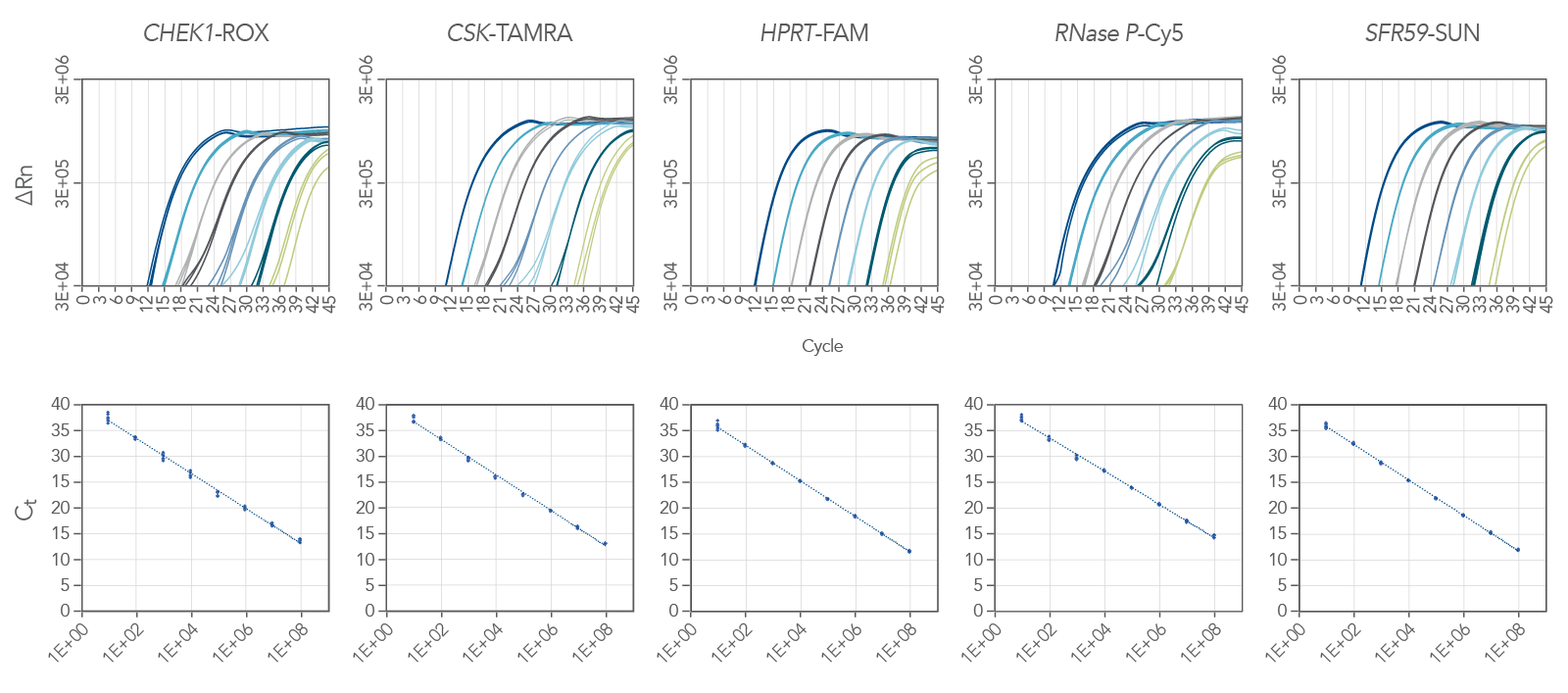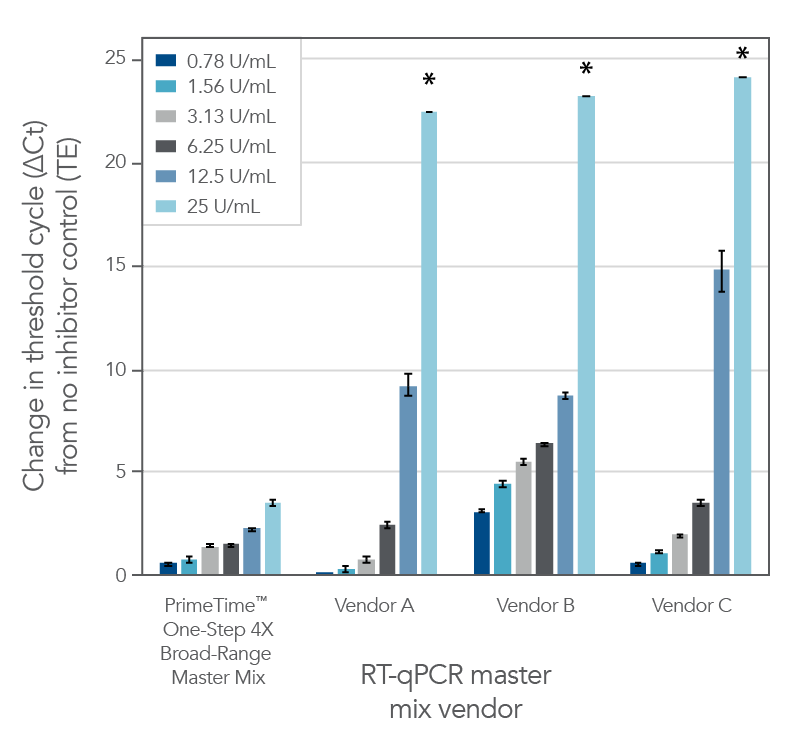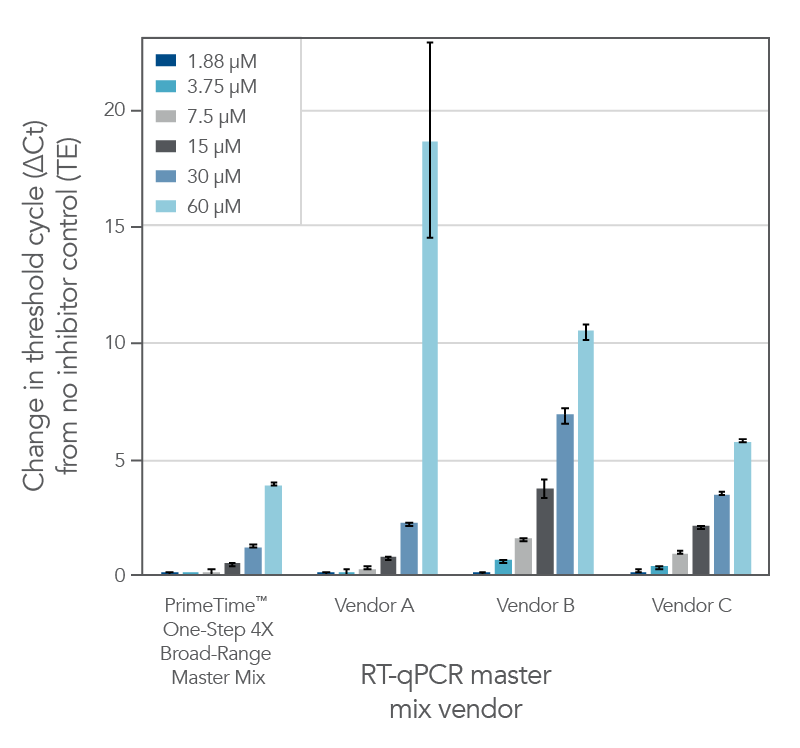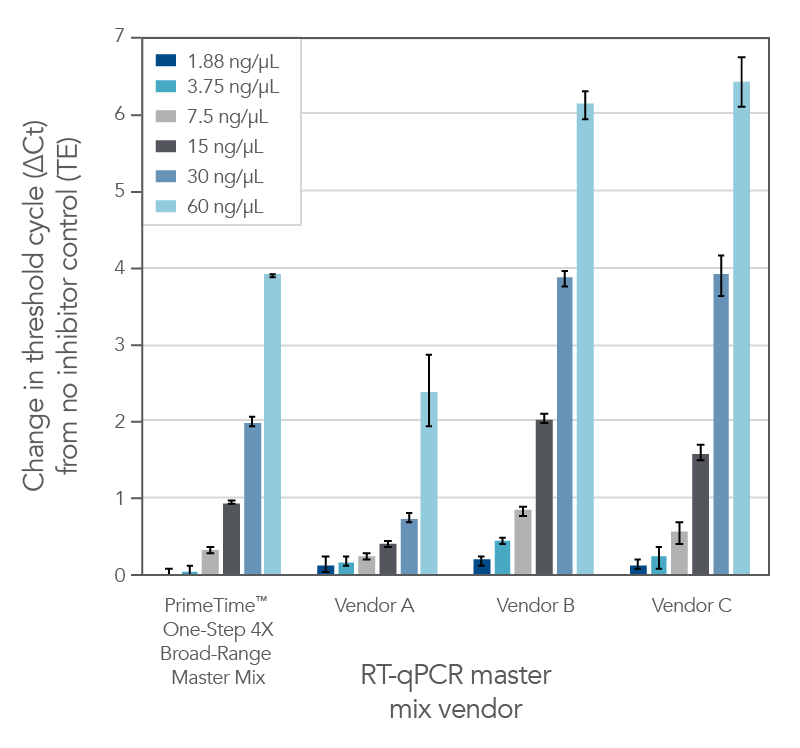PrimeTime™ One-Step 4X Broad-Range Master Mix
PrimeTime One-Step 4X Broad-Range Master Mix is a premium one-step qPCR mastermix that offers advanced capabilities including the flexibility to amplify from crude or purified samples.
Flex—choose the workflow you need.
Ordering
PrimeTime™ One-Step 4X Broad-Range Master Mix
- Flexibility to amplify from either purified or crude samples in viral transport media (VTM)
- Excellent Ct and end-point fluorescence performance compared to leading competitors
- Proven performance for singleplex and multiplex (up to 5-plex) probe assays
- Compatible with multiple market-leading qPCR instruments
- Inhibitor resistant
Request a consultation
The PrimeTime™ One-Step 4X Broad-Range Master Mix is a premium qPCR master mix that will let you either purify or directly amplify from viral transport media (VTM). With this flexibility, you can choose the workflow you need. Need help or want to learn more?
Contact usProduct details
The PrimeTime One-Step 4X Broad-Range Master Mix is a ready-to-use, 4X concentrated master mix that is designed for use in probe-based, real-time quantitative PCR (qPCR). PrimeTime One-Step 4X Broad-Range Master Mix contains a mutant hot-start reverse transcriptase, a mutant hot-start DNA polymerase, dNTPs, MgCl2, enhancers, and stabilizers. An enhancer solution is also provided as an optional additive to neutralize PCR inhibitors, including nucleases in crude samples. A reference dye is provided as a separate component, making this master mix compatible for use on both reference dye-dependent, and independent, instruments. Want to see the potential savings of skipping extraction use our Extraction Cost Savings Calculator.
Product data
Amplify from purified or crude samples in VTM (NP and saliva)
Figure 1. PrimeTime™ One-Step 4X Broad-Range Master Mix demonstrates comparable amplification of viral analytes between extracted and non-extracted human saliva samples. RT-qPCR probe assays containing probes and primers specific for FluA, FluB, SARS-CoV-2, and RNase P were used to amplify 30 copies of AccuPlex™ SARS-CoV-2, Flu A/B and RSV Verification Panel (SARS-CoV-2 data shown) material that had been extracted (dark blue) or direct amplified (light blue). The AccuPlex™ analyte verification panel was first diluted into negative human saliva matrix before RNA extraction or direct specimen amplification, and RNA extractions were performed automated using the KingFisher™ Flex 96 and MagMAX™ Viral/Pathogen II (MVP II) Nucleic Acid Isolation Kit. Reactions were amplified and analyzed using the QuantStudio 7 Flex instrument according to the manufacturer's instructions. Experiments were performed with multiple replicates (n = 20) for each condition.
Figure 2. PrimeTime One-Step 4X Broad-Range Master Mix demonstrates comparable amplification of viral analytes between extracted and non-extracted human nasopharyngeal samples. RT-qPCR probe assays containing probes and primers specific for FluA, FluB, SARS-CoV-2, and RNase P were used to amplify 30 copies of AccuPlex™ SARS-CoV-2, Flu A/B and RSV Verification Panel (SARS-CoV-2 data shown) material that had been extracted (dark blue) or direct amplified (light blue). The AccuPlex™ analyte verification panel was first diluted into negative human nasopharyngeal (NP) matrix before RNA extraction or direct specimen amplification, and RNA extractions were performed automated using the KingFisher Flex 96 and MagMAX™ Viral/Pathogen II (MVP II) Nucleic Acid Isolation Kit. Reactions were amplified and identified using the QuantStudio 7 Flex instrument according to the manufacturer's instructions. Experiments were performed with multiple replicates (n = 20) for each condition.
Lower Ct and higher end-point fluorescence as compared to other commercially available mixes
Figure 3. PrimeTime One-Step 4X Broad-Range Master Mix provides more complete analyte identification from human saliva and nasopharyngeal matrix than competitors. RT-qPCR probe assays containing probes and primers specific for Influenza A (shown), Influenza B, SARS-CoV-2, and RNaseP genes were used to amplify 30 copies of pooled viral analytes spiked into negative human nasopharyngeal (left) or saliva (right) matrix stored in viral transport medium. RT-qPCR reactions were run on the QuantStudio 7 Flex (n = 6).
5-plex amplification
The PrimeTime One-Step 4X Broad-Range Master Mix is suitable for multiplex qPCR. The example below shows amplification of a 5-plex reaction that demonstrates the ability of the master mix to handle these types of challenging experiments. Here, we amplified 5 targets: CHEK1 (ROX), CSK (Tamara), HPRT (FAM), RNase P (Cy5) and SFRS9 (SUN). As seen, the master mix can amplify all targets over 8 logs or RNA template.
Figure 4. PrimeTime One-Step 4X Broad-Range Master Mix provides exceptional multiplexed (5-plex) RNA identification over 8 logs of RNA template. RT-qPCR probe assays containing probes and primers specific for CHEK1, CSK, HPRT, RNase P, and SFRS9 genes were used to amplify a 10-fold dilution series of pooled RNA Ultramer templates ranging from 108 copies, down to 10 copies. RT-qPCR reactions were run on the QuantStudio 7 Flex.
Inhibitor resistant
Samples that contain PCR inhibitors can cause issues with amplification and data analysis. The PrimeTime One-Step 4X Broad-Range Master Mix is designed to handle these types of samples and give consistent amplification results. The data below shows amplification of samples with common PCR inhibitors spiked-in to reactions.
Figure 5. PrimeTime One-Step 4X Broad-Range Master Mix has a higher tolerance to heparin inhibition than three other commercially available master mixes. RT-qPCR probe assays containing probes and primers specific for Flu A (shown), Flu B, SARS-CoV-2, and RNase P genes were used to amplify RNA template in the presence of heparin concentrations ranging from 0.78−25 U/mL. Each master mix was used according to the manufacturer’s instructions. RT-qPCR reactions were run on the QuantStudio 7 Flex (n = 6, per inhibitor concentration per master mix). Error bars represent standard deviation. *Indicates reactions where no amplification occurred in the presence of heparin.
Figure 6. PrimeTime One-Step 4X Broad-Range Master Mix has a higher tolerance to hematin inhibition than three other commercially available master mixes. RT-qPCR probe assays containing probes and primers specific for Flu A (shown), Flu B, SARS-CoV-2, and RNase P genes were used to amplify RNA template in the presence of hematin concentrations ranging from 1.88−60 µM. Each master mix was used according to the manufacturer’s instructions. RT-qPCR reactions were run on the QuantStudio 7 Flex (n = 6, per inhibitor concentration per master mix). Error bars represent standard deviation.
Figure 7. PrimeTime One-Step 4X Broad-Range Master Mix has a higher tolerance to humic acid inhibition than two out of three other commercially available master mixes. RT-qPCR probe assays containing probes and primers specific for Flu A (shown), Flu B, SARS-CoV-2, and RNase P genes were used to amplify RNA template in the presence of humic acid concentrations ranging from 1.88−60 ng/µL. Each master mix was used according to the manufacturer’s instructions. RT-qPCR reactions were run on the QuantStudio 7 Flex (n = 6, per inhibitor concentration per master mix). Error bars represent standard deviation.
Resources
Frequently asked questions
How long can I leave my qPCR mix (containing PrimeTime™ One-Step 4X Broad-Range qPCR Master Mix) at room temperature (or 4°C) and still generate consistent results?
How many freeze-thaw events can the PrimeTime™ One-Step 4X Broad-Range qPCR Master Mix withstand?
We tested 5 true freeze-thaw cycles and no detrimental effects or loss in Cq were observed. The PrimeTime™ One‑Step 4X Broad‑Range qPCR Master Mix is not expected to freeze at –20°C, so 20 use-case scenarios were also tested and once again no detrimental effects or loss in Cq were observed.
Which reference dye is included with the PrimeTime™ Gene Expression Master Mix, the PrimeTime One-Step RT-qPCR Master Mix, and the PrimeTime One-Step 4X Broad-Range qPCR Master Mix?
The reference dye included with our master mixes is ROX.
What is the main difference between the PrimeTime™ One-Step RT-qPCR Master Mix and the PrimeTime One-Step 4X Broad-Range qPCR Master Mix?
The PrimeTime One-Step 4X Broad-Range qPCR Master Mix can also be used in conjunction with our Direct Amplification Enhancer for amplification with crude/non-extracted samples.
Which crude/non-extracted sample types have been tested with the PrimeTime™ One-Step 4X Broad-Range qPCR Master Mix?
The PrimeTime One-Step 4X Broad-Range qPCR Master Mix has also been used with common inhibitors found in blood and soil samples (hematin and humic acid). Testing in actual blood and soil samples is currently underway, and this data will be available soon.
When should the Direct Amplification Enhancer, included with the PrimeTime™ One-Step 4X Broad-Range qPCR Master Mix, be used?
Can I store the PrimeTime™ One-Step 4X Broad-Range qPCR Master Mix at room temperature?
No. Upon receipt, we recommend storing the master mix at –20°C, in a constant temperature (non-frost free) freezer.
My PrimeTime™ One-Step 4X Broad-Range qPCR Master Mix got stuck in shipping. Can I still use it?
How does the PrimeTime™ One-Step 4X Broad-Range qPCR Master Mix compare with one-step master mixes from other manufacturers?
The PrimeTime One-Step 4X Broad-Range qPCR Master Mix also has a high tolerance to PCR inhibitors and can be used on non-extracted samples.
View representative data available here.
Which cycling parameters will give me the best results when using the PrimeTime™ One-Step 4X Broad-Range qPCR Master Mix?
For best results, use the cycling parameters provided in the PrimeTime One-Step 4X Broad-Range Master Mix Protocol.
Fast cycling conditions: 15 min. 50°C; 30 sec. 95°C; 35–45x (5 sec. 95°C, 45 sec. 60°C).